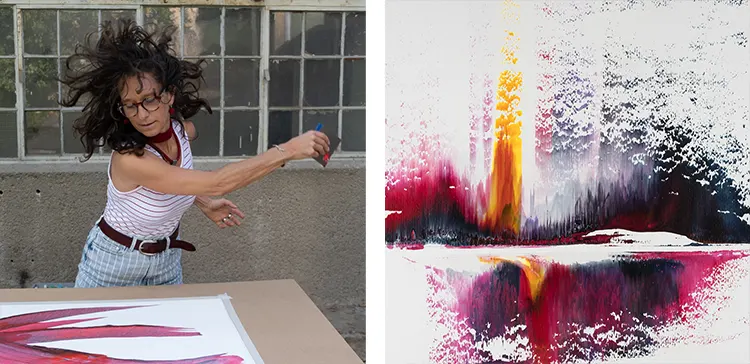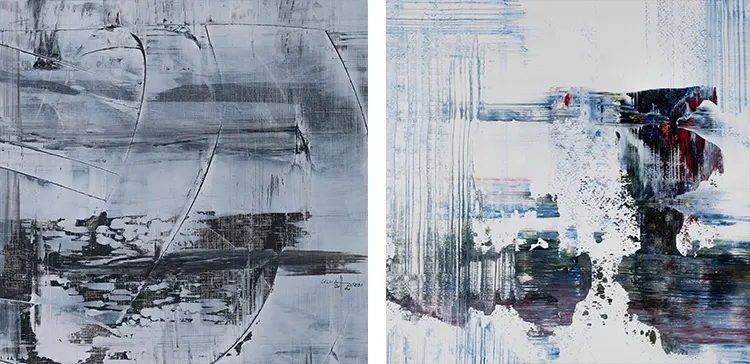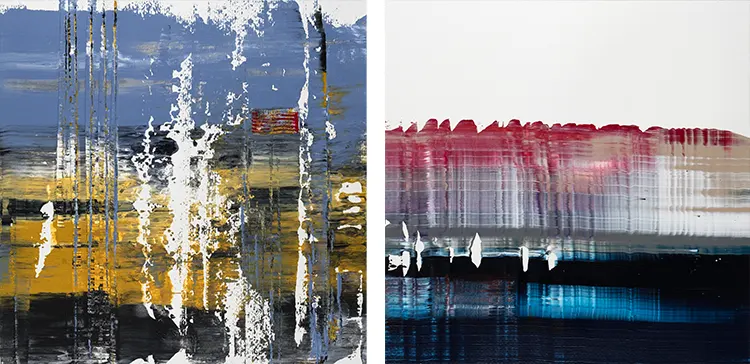“I only started painting and drawing after I had distanced myself from the idea of wanting to depict anything.”
Unveiling the Artistic Philosophy
Ulla Hasen, born in the idyllic city of Wiener Neustadt, south of Vienna, in 1966, spent a significant portion of her early life absorbed in the natural world and under the influence of her artistically inclined grandfather. Despite his impact on her upbringing, Hasen initially resisted the pull towards painting and drawing, believing that she lacked the compulsion to replicate or represent.
Instead, she turned her attention towards studying landscape ecology, and subsequently embarked on a career in nature conservation and sustainable development. Concurrently, Hasen pursued a breadth of academic interests through lifelong courses at the University of Vienna, the Academy of Fine Arts, and the University of Applied Arts. Her studies spanned an array of subjects including cultural theory, anthropology, aesthetic theory, and art history, reflecting a broad intellectual curiosity. Throughout this journey, music and rhythm seeped into the fabric of her work, influencing her artistic perspective.
It was a singular moment of revelation that served as Hasen’s creative catalyst: an encounter with a canvas bearing a bold brushstroke. The sight of this simple, evocative stroke ignited an artistic flame within her, a longing to create such strokes herself. Surrendering to this newfound drive, Hasen tested her hand at painting and was pleased with the results.
Her foray into the world of color and canvas resulted in the creation of hundreds of works. A crucial element in this artistic evolution was her teacher Haider Al-Zubaidi, a mentor who did not impose any structured teaching methods on her. Instead, this figure encouraged Hasen’s playful experimentation and offered insightful analysis of her work post-production. Through this constructive feedback, Hasen began to understand her intuitive artistic process more deeply, nurturing a unique, authentic approach to art.

Ulla Hasen: Embracing Minimalism and Abundance
Ulla Hasen’s artistic practice is intrinsically anti-thematic, driven by capricious impulses that emerge from within or by inspirations gleaned from her environment, such as an unexpected interplay of colors that catches her eye. Her creative journey often takes on a recursive nature, with a constant revision and reimagining of her past work, culminating in the birth of a fresh artistic perspective. Chance occurrences are significant in this progression, frequently leading to unexpectedly pleasing outcomes.
Minimalism is a consistent thread that weaves through Hasen’s oeuvre, a testament to her belief in the inherent potency of simplicity. However, she is equally enchanted by the lavishness and intricacy of abundance. Depending on her creative mood, her work may resonate with dynamic energies or display a more measured emphasis on geometric surfaces and lines. It is not uncommon to discern traces of landscapes or bodily forms in her creations, their silhouettes subtly emerging from her canvas.
An integral component of her creative process is the physical environment. Hasen thrives in a large workspace where paint can freely splash and where there is ample room for her series of artworks to dry. These series are often produced in a single, inspired burst of creativity. Preferring solitude to facilitate concentration, she finds the presence of others to be a potential distraction. Hasen’s ability to immerse herself completely in her work is therefore facilitated by withdrawing into the sanctuary of her studio, where she can channel her focus entirely on her art.

Drawing Inspiration from Artistic Icons
Deeply ingrained in the psyche of Ulla Hasen is the significance of Kasimir Malevich’s minimalist aesthetics. She finds resonance with Malevich’s concept of the white horizon as an equivalent for God’s omnipotence, with the black square being the materialization of it, encompassing everything that exists. This concept, doubling the idea of potential, serves as an inspiration for her, echoing her own experiences with the creative process of painting.
Long before Hasen wielded a brush, she was captivated by the masterful brushstrokes of Markus Prachensky. This initial fascination acted as a beacon, drawing her towards the mesmerizing world of painting. Upon her foray into the medium, the inevitable influence of Gerhard Richter became apparent, especially once she began to explore the intriguing effects yielded by the use of a palette knife.
In her artistic journey, Hasen maintains a careful balance, ensuring that while she acknowledges the influence of renowned artists, she doesn’t allow it to impede her originality. It’s her belief that overindulging in the study of these masters could hinder rather than nurture her creative process. Thus, any artistic parallels she shares with these eminent artists are usually recognized retrospectively, rather than being the focus of her creative intention.
One of Hasen’s notable works is her painting titled “A Tribute to Lyotard’s Angel”. This title draws on the philosophy of the French thinker, where the ephemeral appearance of the angel symbolizes a fleeting, yet profound state of heightened clarity. In this mystifying state, time seemingly stands still and everything unfolds with vivid lucidity, yet remains elusive.
This paradoxical moment, as seen by Hasen, is one of acute awareness wherein contradictions coexist harmoniously; the precise mingles with the ambiguous, and the formed interweaves with the formless. All these elements are suspended in awe-inspiring wonderment, nestled within a temporal hiatus, until life’s relentless momentum once more takes its course. This intricate tapestry of notions, encapsulated within her work, pays homage to Lyotard’s philosophical perspective while adding her unique interpretative strokes.

Ulla Hasen: The Ambitious Project of Merging Worlds
The cornerstone materials for Ulla Hasen are paper and acrylic paints. Early in her artistic journey, Hasen honed her craft on canvas but rapidly transitioned to primarily utilizing paper, reserving canvas for occasional larger works. Her affinity for paper lies in its vast range of qualities, each of which creates a unique interplay with the paint. This leads to a diverse array of effects that hinge upon the absorbency and texture of the paper. To Hasen, the white surface of the paper itself is a critical element in many of her pieces. She acknowledges a practical aspect to her choice as well: the sheer volume of canvas she would amass precludes it as a feasible medium, given her spatial constraints.
Although oil paint holds allure for her due to its potential for slower, more deliberate work, the requirement for ample drying space deters her from regularly employing this medium.
In terms of future ambitions, Hasen harbors aspirations to elaborate on a sketch for a book project and bring it to fruition. The envisioned work is a nuanced marriage of visual and verbal artistry, a picture-text interpretation of Friedrich Nietzsche’s “Midnight Song,” which was famously set to music in the 4th movement of Gustav Mahler’s 3rd Symphony. Accompanying this will be verses by Rainer Maria Rilke, philosophical and literary annotations, insights into the art, and critical discussions on sustainability, all in alignment with the United Nations’ Sustainable Development Goals.
This ambitious project aims to bridge the gap between distinct realms—from imagery to poetic discourse to technical deliberations—creating a holistic narrative that merges worlds often considered distant from one another.






